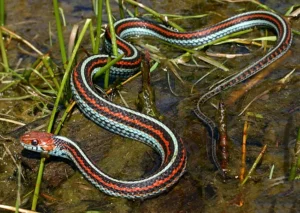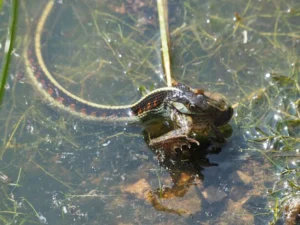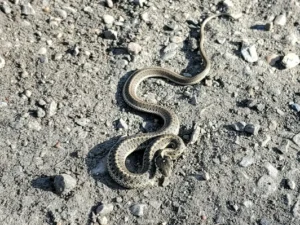Garter snakes are among the most widespread snakes in North America. They live in grassy forest areas, often near ponds, streams, or wetlands.
Garter snakes like water because of the abundance of prey such as earthworms, frogs, fish, and many insects near water bodies. Water also helps garter snakes escape predators, and cool down in hot temperatures.
Garter snakes are considered semi-aquatic snakes, meaning they are comfortable both on land and in the water.
That said,
Garter Snakes Are Semi-aquatic Snakes
Garter snakes are the most common, and widely distributed snakes in North America.
Throughout their range, garter snakes can be found in virtually every terrestrial and wetland habitat.
They live in forests, swamps, meadows, marshes, grasslands, and even in urban areas as long as there is some cover (such as vegetation, debris, or rocks).
All garter snakes are considered semi-aquatic snakes and have adaptions that enable them to thrive both in terrestrial, and wetland habitats.

Their slim, flexible bodies and strong muscles allow them to move swiftly both on the ground and in water.
Garter snakes are very strong swimmers and are as comfortable in the water as they are on land.
Garter snakes of some species are even capable of diving underwater and staying submerged for over 10 minutes.
5 Reasons Why Garter Snakes Are Drawn to Water
Most species of garter snakes are habitat generalists and are capable of surviving away from open water.
However, they generally prefer to live in moist environments, often near permanent surface water, like ponds, lakes, and streams.
Here are 4 reasons why garter snakes like to be near water:
1. Abundance of Prey
Garter snakes have very diverse diets. They are very opportunistic predators and will eat almost anything they can catch, overpower, and swallow whole.
Many of the small animals that garter snakes love to eat are found in, or near water bodies, including;
- Earthworms
- Snails
- Slugs
- Small fish
- Frogs and toads
- Tadpoles
- Salamanders, and newts
Garter snakes take advantage of the abundance of prey found in and around open water sources.

They use their sense of smell, as well as their vision to detect and hunt for prey.
Some garter snakes such as the aquatic garter snake (Thamnophis atratus) flick their tongues above the water – to mimic an insect and lure fish into their mouth.
2. Protection From Predators
Garter snakes are eaten by a wide variety of predators, such as crows, hawks, foxes, raccoons, and even larger snakes.
For this reason, these snakes developed several ways to defend themselves.
As a first line of defense, most garter snakes will remain motionless, and rely on their camouflage to blend into their environment. Their coloration makes them hard to see in grassy areas.
However, when they are spotted by a predator, these snakes will attempt to flee.
A garter snake can quickly slither into a nearby pond or stream, and hide among vegetation, to escape predators on land.
These snakes have the ability to dive underwater and stay for several minutes, enhancing their chances of evading predators.
3. To Regulate Their Temperature
Like all reptiles, garter snakes are cold-blooded (ectothermic) animals.
This means they cannot internally regulate their body temperature. Instead, their body temperature changes with the temperature in their surroundings.
In other words, their environment is the main influence on their body temperature.
As the temperature changes at different times of day and night, garter snakes move around in their environment to regulate their body heat. This is known as “behavioral thermoregulation.”
When their body temperature is low, they move into the sun to warm up, when it is high, they move to the shade or cool water to cool down.
The cool mud found around water bodies can also give garter snakes an escape from the high temperatures during hot days.
4. To Hydrate
Like all living creatures, garter snakes need to consume water to survive.
Dehydration can be harmful, and even potentially lethal to most snakes. Their need for water is as critical as their need for food or oxygen–it’s an essential substance, that keeps their bodies working normally.
Garter snake’s bodies need a steady supply of fluids to transport nutrients, eliminate waste, and perform many other important functions.
That said, it’s important to note that snakes do not drink water like we do. Instead, they drink by sucking water with a sponge-like structure in their mouths.
Proximity to water ensures that garter snakes can easily rehydrate any time they need to.
5. To hibernate
In cold climates, garter snakes survive the winter by brumating (think of it as a kind of hibernation, for cold-blooded animals).
They seek out protected places where they will not freeze, such as under rock piles, in tree stumps, or in animal burrows that are deep enough that the frost does not penetrate all the way to the bottom.
Garter snakes in some regions are even known to hibernate underwater.
In one study, researchers exposed 2 groups of eastern garter snakes (Thamnophis sirtalis sirtalis) to the conditions they would experience during hibernation in the winter.
One group was left exposed to the air at a temperature of 41°F (5°C) for 165 days.
Another group was submerged in water and at the same temperature.
The researchers found that the garter snakes that were exposed to the air got dehydrated and died.
However, the snakes that hibernated in water remained hydrated and survived.
Based on this study, hibernating underwater may be a necessity for garter snakes in some regions.
It is also thought since garter snakes that hibernate underwater conserve more energy, they have an advantage over those that hibernate on land – when the breeding season begins in the spring.
Some Garter Snakes Are More Aquatic Than Others
Although all garter snakes prefer to live near water, some species are more likely to be around water than others.
For example, western terrestrial garter snakes (Thamnophis elegans), are primarily terrestrial, and can often be found far from water bodies.

On the other hand, aquatic garter snakes are rarely found away from water.
Garter Snakes Can Survive Away From Water
Garter snakes are highly adaptable and can live in almost any type of habitat they find themselves in.
They prefer to be around water, but its open water is not a requirement for their survival.
Garter snakes can thrive even away from water, as long as they have moist areas nearby where they can cool down and rehydrate.
Their opportunistic nature (both in habitats and food habits) is one of the reasons snakes are so common.
Garter snakes are sometimes found in suburban gardens and around barns and houses.
They have also been found in abandoned buildings and trash heaps, far away from any open water.
Conclusion
Garter snakes are semi-aquatic, which means they are comfortable both on land and in the water.
Many garter snakes are drawn to water bodies to hunt for worms, fish, toads, frogs, and other prey animals that are abundant in these habitats.
Also, garter snakes can easily slither into the water to cool down on a hot day, and escape the high temperatures.
In some regions, garter snakes survive the winter by hibernating underwater. By doing this, they conserve energy and stay hydrated all winter long.
Featured image credit: Ed Hass (CC BY-NC-ND 4.0)
Sources:
Jon P. Costanzo. 1989. Effects of humidity, temperature, and submergence behavior on survivorship and energy use in hibernating garter snakes, Thamnophis sirtalis. Canadian Journal of Zoology. 67(10): 2486-2492. https://doi.org/10.1139/z89-351
CundallD, BrainerdEL, ConstantinoJ, DeufelA, GrapskiD, KleyNJ. 2012. Drinking in snakes: resolving a biomechanical puzzle. J. Exp. Zool. 317: 152–172.
Hi, my name is Ezra Mushala, i have been interested animals all my life. I am the main author and editor here at snakeinformer.com.

